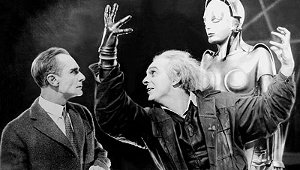German Expressionism
 German Expressionism is a trend, which at the beginning of the last century brought a breakthrough solution: formal, linguistic and thematic, and which has its followers to this day.
German Expressionism is a trend, which at the beginning of the last century brought a breakthrough solution: formal, linguistic and thematic, and which has its followers to this day.
____________________________________________
GERMAN EXPRESSIONISM. PLAYING WITH CREATION
“Expressionism is a game. But why not, after all? Nowadays everything is but a game!” – in “Dr. Mabuse” (1922) the words are spoken by the film’s eponymous hero. They should however be attributed to Fritz Lang’s, the film director’s, perversity as, to some extent, he meant the mad doctor to be his own porte-parole. In a few years, Lang would create “Metropolis” only to prove that film creators will ever since partake in the light and shadow play.
“The Cabinet of Dr Caligari” (1920) by Robert Wiene proved to be a milestone for expressionism. Its premiere screening may be branded the day when artistic film was born – genre addressed to sparse audience, a little snobbish perhaps albeit well familiar with aesthetic trends. The plot alone is very much intriguing: a series of murders occurs in the town of Hosltenwall. Charlatan Caligari is to be held responsible for those as he turns sleepwalking Cesar into his lethal marionette. Misé en scene in the film was a breakthrough: originating from theatre and painting, aesthetics of expressionism was transplanted onto a movie set. A sheer atelier fabrication, the scenery was ostentatiously artificial, full of deformations, unrealistic interiors and locations. Not without a cause expressionism is frequently referred to as set designers’ cinema. Film parted once and for all with faithful depiction of the reality, offering in exchange pure creation.
Expressionism is a wide notion that functions in the history of cinematography within three basic contexts. Firstly, as caligaristic expressionism i.e. one encompassing works of art that use disfigured scenery, at odds with illusionism and Renaissance perspective, full of zigzags and sharp angles. There were only a few of such films. Many more resorted to means of expression developed by world cinema. These are all effects designed to bring on thick, dark ambience: low key shoots, special camera angles, shadow exploitation, occasional double exposition (i.e. combined photos). In its third meaning, expressionism stood for films that make references to German culture, with fantastical and extraordinary plots. Thus perceived, it started as early as in 1913 with Paul Wegener’s “The student of Prague”.
Retrospective encompasses films representative of the movement that significantly affected creators still to come. “The last laugh” (1924) is a prominent example of Kammerspiel, literary translation of which is “chamber drama”. Murnau manages to evoke a unique atmosphere of confusion and despair and he does so only through purely cinematic means without resorting to intertitles, seen as disruptive to the narrative’s flow. Liberated, perfectionist camera work of a brilliant cameraman Karl Freund won the film an international success. Hollywood producers loved it and it is where Murnau would complete his multi-Oscar winning (during the first ceremony in the history of this award) “Sunrise” (1927) thus transplanting European aesthetics into American cinema.
“Metropolis” (1972) by Fritz Lang has secured its place in collective imagination of cinema enthusiasts as well as in pop culture canon. Gotham city in “Batman” (1989) or futuristic space in “Blade runner” (1982) – no movie depicting dystopian future may stay indifferent towards this masterpiece. In turn, “M” (1931) is an ambitious attempt at creating an elusive atmosphere of danger and mystery in the domain of sound film, unfamiliar still as it was at that time. The attempt resulted with probably the greatest murderer character ever.
Not coincidentally expressionism entered cinemas in the 20’s withering gradually with the onset of the 30’s. In 1933 Hitler gained power and according to Siegfried Kracauer’s analysis expressionism was a manifestation of collective unawareness of Weimar society and a herald of a prompt triumph of Nazism. A number of German directors (including many of Jewish origin, headed by Fritz Lang himself) emigrated to the USA to provide their expressionism-rooted contribution to a new phenomenon: film noir.
Sebastian Smoliński
Last Laugh, The | Der letzte Mann – dir. Friedriech Wilhelm Murnau, 1924
date: 30/07/2012 time: 10:00 place: PGE Cinema film program: German Expressionism artistic program: filmsM | M – Eine Stadt sucht einen Mörder – dir. Fritz Lang, 1931
date: 01/08/2012 time: 10:00 place: PGE Cinema film program: German Expressionism artistic program: filmsMetropolis | Metropolis – dir. Fritz Lang, 1927
date: 02/08/2012 time: 10:00 place: PGE Cinema film program: German Expressionism artistic program: filmsSunrise: A Song of Two Humans – dir. Friedriech Wilhelm Murnau, 1927
date: 31/07/2012 time: 10:00 place: PGE Cinema film program: German Expressionism artistic program: films









